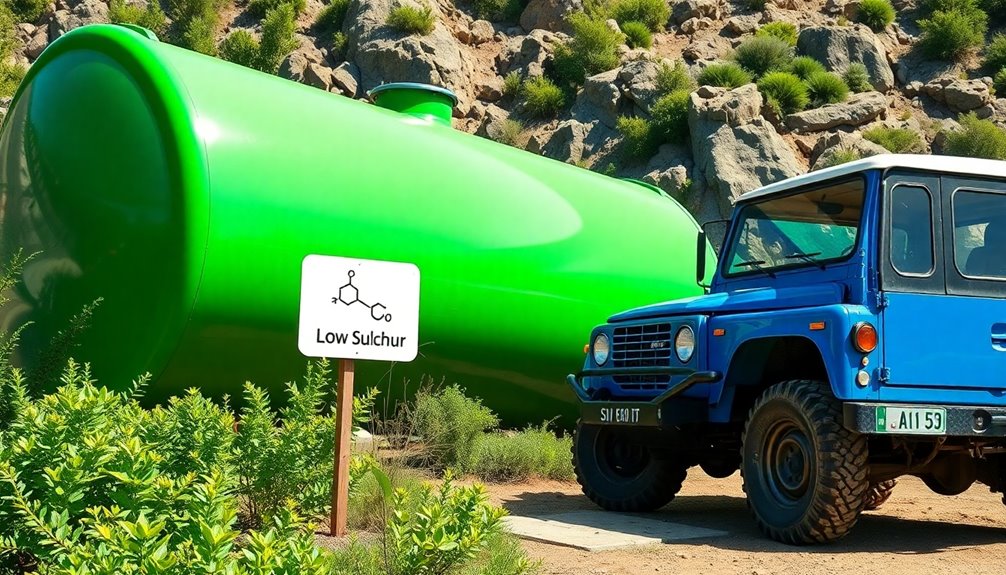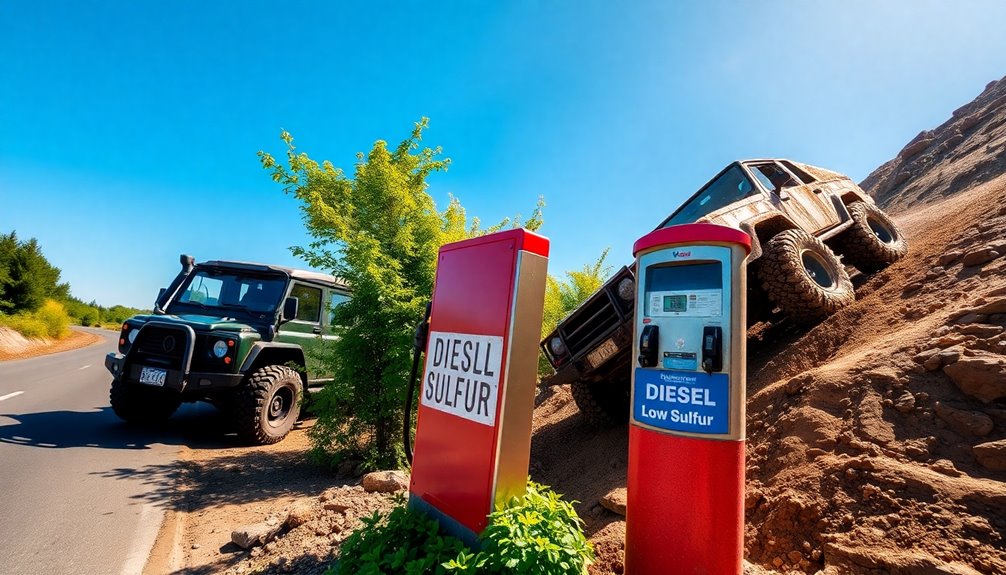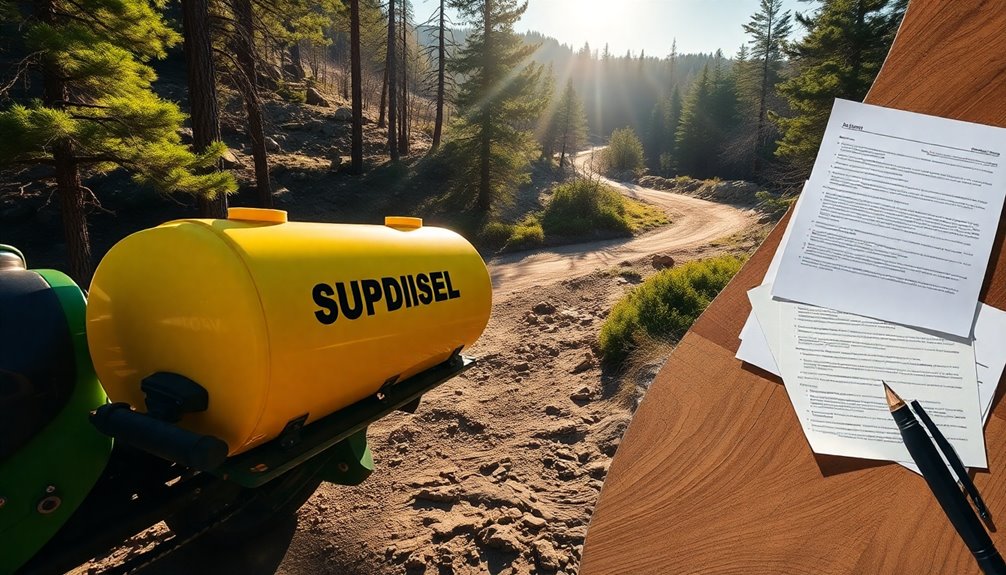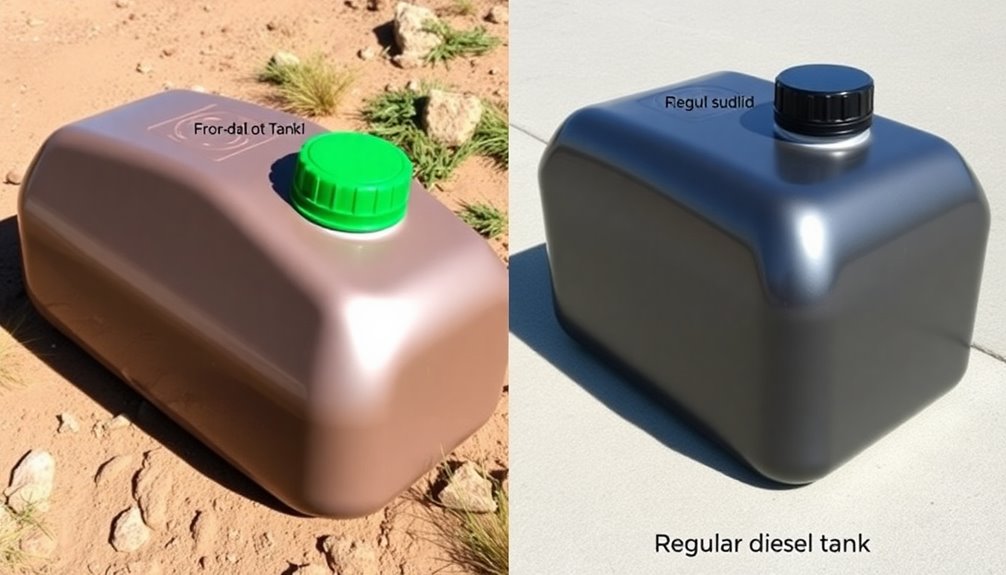Yes, off-road diesel is low sulfur. Also known as red diesel, it contains less than 15 parts per million (ppm) of sulfur, classifying it as ultra-low sulfur diesel (ULSD). This standard has been in effect since June 2010 to comply with environmental regulations. The low sulfur content helps improve engine efficiency and reduces harmful emissions, providing both environmental and economic benefits. Plus, it's important to remember that using off-road diesel in on-road vehicles can lead to hefty fines. There's more to discover about its impact and regulations, so keep exploring for additional insights.
Key Takeaways
- Off-road diesel, also known as red diesel, is classified as ultra-low sulfur diesel (ULSD) with a maximum sulfur content of 15 ppm.
- Since June 2010, all blends of off-road diesel must meet ULSD standards for environmental compliance.
- Low sulfur diesel significantly reduces sulfur dioxide emissions, improving air quality and public health.
- Both off-road and on-road diesel meeting ULSD standards ensure similar engine performance and efficiency.
- Compliance with low sulfur diesel regulations is essential to avoid legal penalties and demonstrate environmental stewardship.
Understanding Off-Road Diesel

When you think about off-road diesel, often called red diesel, it's important to understand its unique characteristics and regulations. This dyed diesel is specifically designed for non-road applications, such as agriculture and construction, and it's untaxed for these purposes.
Most off-road diesel now contains less than 15 parts per million (ppm) sulfur, qualifying it as ultra-low sulfur diesel (ULSD). This change guarantees compatibility with modern diesel engines and aligns with emissions control initiatives.
Historically, off-road diesel had higher sulfur levels, but regulatory changes effective from June 2010 mandated all blends meet ULSD standards. This shift improves fuel quality and reduces harmful emissions.
However, keep in mind that off-road diesel can gel in cold temperatures, so you'll need to treat it during winter to maintain fluidity and prevent filter blockages below 20°F.
Regular testing of off-road diesel is essential to guarantee it remains compliant with fuel specifications and maintains its quality.
Low Sulfur Regulations Explained

How do low sulfur regulations impact the diesel you use? Understanding these regulations helps you appreciate the benefits of off-road diesel fuel. Since June 2010, off-road diesel must meet the Ultra-Low Sulfur Diesel (ULSD) standard, limiting sulfur content to just 15 parts per million (ppm). This change has drastically reduced harmful emissions that contribute to air pollution.
Here are three key points about low sulfur regulations:
- Uniform Standards: Both on-road and off-road diesel fuels are now chemically identical regarding sulfur content, ensuring consistency across various applications.
- Non-road Diesel Regulations: Effective since 2014, these regulations further enforce low sulfur content for non-road diesel, making it environmentally compliant and better for engine health.
- Enhanced Performance: The reduction of sulfur supports advanced emissions control technologies, which improve overall diesel engine performance and efficiency.
Environmental Impact of Low Sulfur

The shift to low-sulfur diesel has significant implications for environmental health. By containing a maximum of 15 parts per million (ppm) sulfur, low-sulfur diesel drastically reduces sulfur dioxide emissions compared to traditional diesel, which can have up to 500 ppm. This reduction in harmful emissions directly contributes to improved air quality, promoting public health and environmental sustainability.
When you use low-sulfur diesel, you not only enhance your engine's performance, but you also support advanced emissions control technologies like diesel particulate filters. These technologies work effectively with low-sulfur diesel, helping to meet regulatory emissions standards aimed at protecting both the environment and public health.
In areas that adopt low-sulfur diesel, there's a noticeable decrease in respiratory issues, including asthma and bronchitis, linked to high sulfur emissions. By minimizing sulfur emissions, you play an essential role in fostering healthier communities.
The benefits extend beyond just cleaner air; they contribute to a more sustainable environment for everyone. Embracing low-sulfur diesel is a proactive step toward enhancing air quality and safeguarding public health for future generations.
Performance Comparisons: Off-Road vs. On-Road

When comparing off-road and on-road diesel, you'll find that both fuels meet the same Ultra Low Sulfur Diesel standards, which can lead to similar engine performance and fuel efficiency.
However, you might notice some differences in injector wear and how each type performs in specific machinery.
Understanding these nuances can help you choose the right fuel for your needs.
Engine Performance Differences
While you might wonder about the differences in engine performance between off-road and on-road diesel, both fuels are now classified as Ultra-Low Sulfur Diesel (ULSD) with a maximum sulfur content of 15 parts per million (ppm). This means you can expect similar engine performance characteristics when using either type.
Here are three key points to take into account:
- Performance Consistency: Users often report no significant differences in engine performance between off-road and on-road diesel. In fact, some even perceive enhanced performance with ULSD due to its cleaner burn.
- Impact on Older Machinery: Off-road diesel may have had higher sulfur levels before regulations changed, which could affect engine performance and emissions for older machinery not designed for ULSD.
- Emissions Control: Modern diesel engines equipped with sensors perform ideally with ULSD. Using higher sulfur off-road diesel can increase emissions and possibly damage emissions control technologies.
Fuel Efficiency Metrics
Fuel efficiency metrics for off-road and on-road diesel showcase a surprising similarity, given that both fuels comply with Ultra-Low Sulfur Diesel (ULSD) standards. Users generally report no significant difference in fuel mileage between the two types, as they're chemically identical under current regulations. This means you can expect similar fuel performance, whether you're using off-road diesel for heavy machinery or on-road diesel for trucks.
While some believe off-road diesel offers better engine performance due to its higher lubricity, this perception may stem from placebo effects rather than actual efficiency differences. In reality, fuel mileage tends to remain consistent across various diesel blends, indicating that the intended use of diesel doesn't dramatically impact fuel efficiency metrics.
To maximize performance, it's essential to focus on fuel maintenance. Regular testing and maintenance of your fuel tanks help guarantee peak performance and mitigate issues related to contaminants that could affect fuel efficiency.
Injector Wear Impact
Using off-road diesel in on-road applications can considerably impact injector wear and overall engine performance. While off-road diesel might seem like a cost-effective option, it often contains higher sulfur content, which can lead to significant injector wear over time.
Here are three key factors to evaluate:
- Injector Wear: The higher sulfur levels in some off-road diesel varieties can cause injector clogging, negatively affecting engine performance. Modern engines are designed for ultra-low sulfur diesel (ULSD), typically limited to 15 ppm sulfur.
- Emissions: Off-road diesel can increase harmful emissions due to its sulfur content. This can conflict with advanced emissions control technologies in newer vehicles, leading to potential compliance issues.
- Maintenance Practices: Regular fuel testing and proper filtration are essential when using off-road diesel. These maintenance practices help mitigate the risks of contaminants and maintain peak engine performance.
Legal Considerations for Diesel Use

When it comes to legal considerations for diesel use, understanding the distinctions between off-road and on-road diesel is essential. Off-road diesel, often referred to as dyed diesel, must comply with Ultra-Low Sulfur Diesel (ULSD) regulations, limiting sulfur content to a maximum of 15 parts per million.
Using off-road diesel in on-road vehicles is illegal and can lead to hefty penalties, including fines up to $10,000 in some states, like Oregon.
It's important to note that off-road diesel is tax-exempt for non-road applications, while on-road diesel incurs federal and state fuel taxes due to its use on public roadways.
Regulatory authorities actively inspect and test diesel to guarantee compliance with emissions regulations, including checking for the distinctive red dye in off-road diesel.
These legal considerations underline the critical nature of using the correct type of diesel for your applications. Misusing off-road diesel not only poses legal risks but can also undermine environmental efforts.
Staying informed about these regulations guarantees you're using diesel responsibly and within the law.
Benefits of Low Sulfur Diesel

Low sulfur diesel offers notable advantages that can benefit both the environment and your operations. By using low sulfur diesel, especially in off-road applications, you can considerably reduce harmful emissions, helping improve air quality in your community.
Here are three key benefits:
- Enhanced Engine Performance: Low sulfur diesel supports advanced emissions control technologies like diesel particulate filters. This not only boosts engine performance but also reduces maintenance costs over time.
- Lower Operational Costs: With less sulfur dioxide emitted, your engines experience less wear and tear, prolonging the life of critical components. This means you'll save money on repairs and replacements.
- Regulatory Compliance and Environmental Protection: Using low sulfur diesel aligns with regulatory standards aimed at reducing air pollution. This compliance not only fulfills legal requirements but also demonstrates your commitment to environmental protection and public health.
Incorporating low sulfur diesel into your operations isn't just a smart move for your business; it's also a step towards a cleaner, healthier environment.
Frequently Asked Questions
Does Off-Road Diesel Have More Sulfur?
You might wonder if off-road diesel has more sulfur than on-road diesel. Historically, it did, with levels sometimes exceeding 500 ppm.
However, since regulations changed, both types of diesel now contain less than 15 ppm of sulfur. This shift means that off-road diesel is fundamentally the same as on-road diesel regarding sulfur content.
Which Diesel Has the Lowest Sulfur?
You might think all diesel fuels are the same, but that's not the case.
When it comes to sulfur content, Ultra-Low Sulfur Diesel (ULSD) takes the lead, containing a maximum of just 15 parts per million.
Since regulations tightened, this has become the standard for both highway and off-road use.
When Did Off-Road Diesel Become Low Sulfur?
Off-road diesel became low sulfur in June 2014 when the Ultra-Low Sulfur Diesel (ULSD) regulations were implemented.
Before that, sulfur levels could reach up to 500 parts per million, contributing to higher emissions.
Since the switch, all diesel fuels, including off-road, must meet the same standards, which limits sulfur to just 15 parts per million.
This change aims to improve air quality and reduce harmful emissions from diesel engines.
Is There a Difference Between Off-Road Diesel and Regular Diesel?
You might think off-road diesel and regular diesel are the same, but they're not.
The key difference lies in their use and taxation. Off-road diesel is dyed red and untaxed, intended for agricultural and construction equipment, while regular diesel is clear or slightly green, taxed for on-road vehicles.
Although they share the same sulfur content now, using off-road diesel in on-road vehicles is illegal and can lead to hefty fines.
Conclusion
In the grand tapestry of diesel use, low sulfur off-road diesel emerges as a cleaner, greener thread. By choosing this option, you're not just fueling your machinery; you're nurturing the earth, helping to clear the air of harmful pollutants. It's like planting a seed for a brighter tomorrow, where engines purr smoothly and nature thrives alongside your work. Embrace the shift to low sulfur diesel, and watch as your efforts blossom into a more sustainable future.









